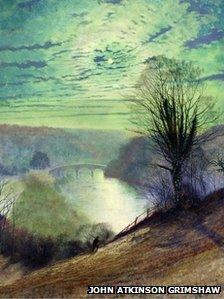Teesdale put on the 'tourist map' through Scott's poem
- Published

John Atkinson Grimshaw painted On the Tees, near Barnard Castle in 1868
An exhibition in Barnard Castle is celebrating the 200th anniversary of a Sir Walter Scott poem which put Teesdale on the "tourist map".
Rokeby: (Poetry and Landscape) Walter Scott & Turner in Teesdale, marks 200 years since the publication of Scott's poem Rokeby in 1813.
Set in Teesdale during the English Civil War, it tells the story of two lovers, treasure and ghosts.
The exhibition at The Bowes Museum celebrates the historical importance of the poet and his influence in attracting artists such as Turner, Atkinson Grimshaw, and Alfred William Hunt to the region.
Edinburgh-born Scott was a poet, novelist and playwright, most well-known in the north-east of England for his poem Rokeby.
He came to the region in 1809 to visit his friend John Morritt's country estate, Rokeby Park, after being inspired by the scenery.
It was his lengthy correspondence with Morritt which provided the basis of the poem - gathering extensive notes on Teesdale's folklore, its beauty spots and its history.
'Dramatic and compelling'
Emma House, keeper of fine art at The Bowes Museum, said: "The landscape is so dramatic and so beautiful and it fitted in perfectly with the poem set in the English Civil War.
"He [Scott] was really interested in not just telling the story, as it is quite dramatic and compelling, but with tying it in with the architecture and the landscape, to make it more atmospheric."
Ms House said by referring to the "sheer beauty" and the "richness" of the architecture and architectural ruins in Teesdale like Egglestone Abbey and Mortham Tower, Scott concretely set the scene for his poem.
After the publication of the poem, Ms House said there was a "rise in tourism and interest" in the area, making Teesdale "famous" with tourists.
Barnard Castle Town Council clerk, Michael King, said: "Barnard Castle is hugely proud of its artistic links, whether those date back to the 1800s, like Scott, Turner and Dickens, or a contemporary, like Anne Fine.
"It's fantastic that there's an opportunity to celebrate these links through The Bowes Museum and to celebrate others who have come here, been wowed by the place and shared their sense of wonder with the world."
The exhibition also explores the importance of Teesdale in the development of landscape painting in the 19th century.
Turner carried out an in-depth study of Teesdale visiting the area several times for his sketches.
He produced 20 views for Whitaker's History of Richmondshire, four of which relate to locations in Rokeby, before Scott commissioned Turner to illustrate newer editions for the poem.
The museum has loaned the landscape art from the British Museum, Tate, and regional galleries for the exhibition.
Ms House said: "I think the fact that so many artistic visitors came. I think people were very proud of it.
"There is probably a generation of people who aren't familiar with the poem and it will be great to introduce them to Scott's work and the landscapes and all of those that were influenced by it.
"I think it's probably the first time that such a big number of loans of Teesdale landscapes have been brought together and it's an opportunity for people to see artwork that they won't be familiar with."
Rokeby: Poetry and Landscape; Walter Scott and Turner in Teesdale, is on show at The Bowes Museum from Saturday 26 January - Sunday 13 April.
- Published6 February 2012
- Published25 October 2011